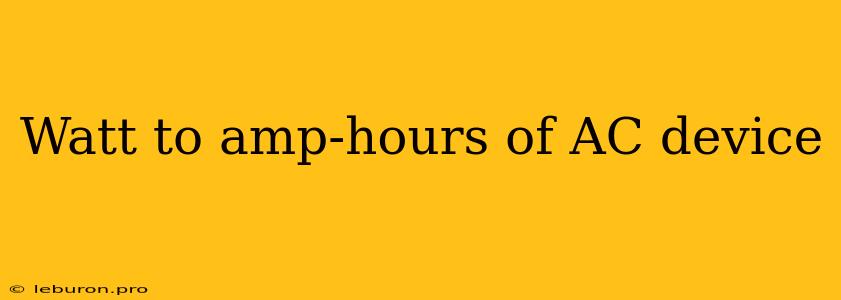Determining the relationship between watts and amp-hours can be confusing, particularly when dealing with alternating current (AC) devices. While watts measure the instantaneous power consumption of a device, amp-hours quantify the total electrical charge a battery can deliver. Understanding this distinction is crucial for accurately sizing batteries for AC devices, ensuring they can provide the necessary power for the required duration. This article will delve into the conversion process between watts and amp-hours for AC devices, outlining the factors that influence this relationship and offering practical guidance for battery selection.
Understanding Watts and Amp-Hours
Watts (W) represent the rate at which electrical energy is consumed by a device. It is calculated by multiplying the voltage (V) across the device by the current (A) flowing through it:
Watts (W) = Volts (V) x Amps (A)
Amp-hours (Ah), on the other hand, measure the total electrical charge a battery can store and deliver. It is calculated by multiplying the battery's current capacity (A) by the time (h) it can sustain that current:
Amp-hours (Ah) = Amps (A) x Hours (h)
Converting Watts to Amp-Hours
Directly converting watts to amp-hours is not possible because they represent different quantities. Watts measure power consumption, while amp-hours measure battery capacity. However, you can determine the required amp-hour capacity for a specific AC device by considering its power consumption and the desired operating time.
Factors Affecting Conversion
Several factors influence the conversion between watts and amp-hours for AC devices:
- Voltage: AC devices operate on specific voltages, usually 120V or 240V. The device's voltage must match the battery's output voltage or a voltage converter is needed.
- Power Consumption: The device's power consumption in watts determines the amount of energy it consumes per hour.
- Efficiency: Inverters, used to convert DC battery power to AC, have varying efficiencies. A less efficient inverter will consume more battery power to deliver the same AC power.
- Operating Time: The desired duration the device should operate on battery power determines the total energy requirement.
Calculating Amp-Hour Capacity
To calculate the required amp-hour capacity for an AC device, you can follow these steps:
- Determine the device's power consumption in watts.
- Calculate the total energy consumption in watt-hours (Wh) by multiplying the power consumption by the desired operating time in hours.
- Convert watt-hours (Wh) to amp-hours (Ah) by dividing by the battery's voltage.
- Consider the inverter efficiency and adjust the amp-hour capacity accordingly.
For example:
Consider an AC device with a power consumption of 500 watts that you want to run for 4 hours on battery power. Assuming a 12V battery and an inverter efficiency of 85%:
- Power consumption: 500 watts
- Total energy consumption: 500 watts x 4 hours = 2000 watt-hours (Wh)
- Amp-hour capacity: 2000 Wh / 12V = 166.67 Ah
- Adjusted amp-hour capacity: 166.67 Ah / 0.85 (inverter efficiency) = 196.14 Ah
Therefore, you would need a 12V battery with a minimum capacity of 196.14 Ah to power the device for 4 hours.
Selecting the Right Battery
When choosing a battery for an AC device, consider the following factors:
- Amp-hour Capacity: Ensure the battery has sufficient capacity to meet the calculated amp-hour requirement.
- Voltage: Select a battery with a voltage that matches the device's requirements or use a voltage converter.
- Battery Chemistry: Consider the type of battery chemistry, such as lead-acid, lithium-ion, or deep cycle batteries, based on the application's specific needs and environment.
- Discharge Rate: Choose a battery with a discharge rate that can handle the device's power requirements.
- Battery Life Cycle: Assess the battery's life cycle to determine its longevity and suitability for long-term use.
Conclusion
Converting watts to amp-hours for AC devices involves understanding the relationship between power consumption and battery capacity. By considering factors such as voltage, power consumption, efficiency, and operating time, you can accurately determine the required amp-hour capacity for your application. Selecting the right battery with sufficient capacity, voltage, discharge rate, and life cycle ensures reliable power for your AC devices. Remember that this conversion is a crucial step in ensuring proper battery sizing for powering your AC devices, providing the necessary runtime and reliable performance.
